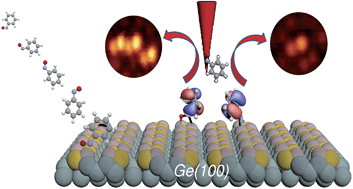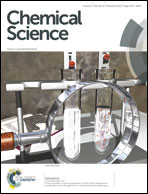Resolving molecular orbitals self-decoupled from semiconductor surfaces†
Abstract
Resolving orbitals using scanning tunneling microscopy (STM) provides an in-depth understanding of the chemical and electronic nature of molecule/substrate junctions. Most orbital resolving work was performed for molecules physisorbed on metal surfaces by inserting interfacial layers to decouple the interaction between the molecules and substrates. It remains challenging to image the orbitals of molecules directly chemisorbed on native surfaces because the linking chemical bonds likely induce severe coupling. Here we demonstrate that the π orbitals of the phenyl rings of nitrosobenzene chemisorbed on Ge(100) are electronically decoupled from the semiconductor surface and can be resolved by STM. Four types of dumbbell-like molecular features are imaged, corresponding to the intradimer and interdimer [2 + 2] nitrosoadducts. In these products, nitrosobenzene binds to Ge(100) through its N![[double bond, length as m-dash]](https://www.rsc.org/images/entities/char_e001.gif) O group, which spatially separates and electronically decouples the phenyl ring (C6H5–) from the substrate. Theoretical calculations and STM simulation reveal that the dumbbell-like features resemble the occupied π orbitals of benzene. Our results show that electronic decoupling and orbital resolving can be achieved for molecules binding to highly reactive surfaces via the sacrifice of a double bond as the anchoring/spacing group.
O group, which spatially separates and electronically decouples the phenyl ring (C6H5–) from the substrate. Theoretical calculations and STM simulation reveal that the dumbbell-like features resemble the occupied π orbitals of benzene. Our results show that electronic decoupling and orbital resolving can be achieved for molecules binding to highly reactive surfaces via the sacrifice of a double bond as the anchoring/spacing group.


 Please wait while we load your content...
Please wait while we load your content...